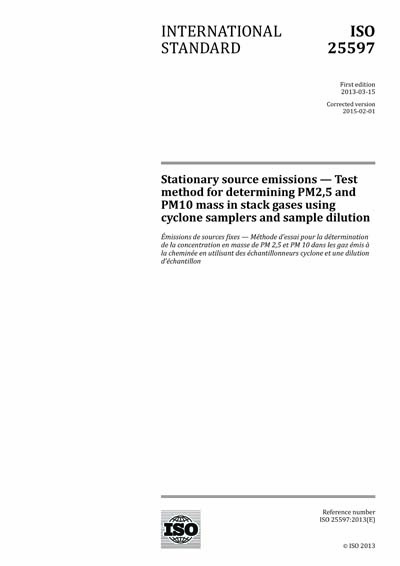Most recent
ISO 25597:2013
Stationary source emissions - Test method for determining PM2,5 and PM10 mass in stack gases using cyclone samplers and sample dilution
ISO 25597:2013 specifies procedures for the extraction and measurement of filterable particulate matter from stationary source flue gas samples by: a) the use of cyclone samplers; b) the measurement of condensed particulate matter using dilution sampling technique, which simulates the interaction of stack gas components with the atmosphere as they mix after the stack exit.
ISO 25597:2013 provides for the use of two types of sampling train.
1) Basic sampling train, a basic sampling train to measure filterable particles using sampling cyclones that can distinguish between particle sizes in the range of 2,5 μm and 10 μm. This method is especially suitable for measurements of particle mass concentrations above 50 mg/m3 as a half-hourly average at standard conditions (293 K, 1 013 hPa, dry gas) and applies to primary particulate matter (PM) emissions equal to or less than an aerodynamic diameter of nominally 10 μm (PM10) from stacks or ducts.
2) Dilution sampling train, a dilution sampling train that utilizes a dilution chamber that mixes flue gas with conditioned dilution air to simulate the interaction of the stack gas components with ambient air. This simulation process may lead to the condensation of particulate matter that might not otherwise be produced in the basic sampling train. The dilution sampling train uses in-stack sampling cyclones to measure filterable particles in the same manner as the basic sampling train, but in addition, utilizes additional PM2,5 and/or PM10 cyclones in the sampling train to measure particles formed in the dilution chamber.
This method is intended for the measurement of mass concentrations of particles smaller than 2,5 μm aerodynamic diameter (PM2,5) using weighing techniques. The method can be used to measure mass concentrations of particles with aerodynamic diameter smaller than 10 μm aerodynamic diameter (PM10) or particles with aerodynamic diameters between 2,5 μm and 10 μm.
In this method, the dilution sampling train can be used in combination with the basic sampling train, using PM10 and/or PM2,5 depending upon the test objectives. The dilution sampling system is intended for applications where measurement is required of particles similar in characteristics to materials formed when a flue gas exhaust mixes with ambient air.
Particulate matter filter samples collected using dilution sampling can be further analysed to provide chemical composition data that are applicable for developing PM2,5 or PM10 emission inventories, visibility impact assessments, health risk assessments, and source?receptor studies related to PM2,5 and PM10 emissions.
This method is not applicable to the determination of ultrafine particles with an aerodynamic diameter of less than 0,1 μm. This method has been applied to emission sources with low moisture and saturated moisture stack gases; however, it is not applicable to effluents where entrained water droplets are present.
It is recognized that there are some combustion processes and situations that can limit the applicability of ISO 25597:2013. Where such conditions exist, caution and competent technical judgment are required, especially when dealing with any of the following: i) high-vacuum, high-pressure or high-temperature gas streams above 260 °C; ii) fluctuations in velocity, temperature or concentration due to uncontrollable variation in the process; iii) gas stratification due to the non-mixing of gas streams.
There are also limitations specific to each sampling technique.
Stacks with entrained moisture droplets can have droplet sizes larger than the cut sizes for the cyclones. These water droplets normally contain particles and dissolved solids that become PM10 and PM2,5 following evaporation of the water.
For dilution sampling, a known limitation of this method concerns the presence of particles in the dilution air at very low concentrations, contributing to measurement background. This can be significant for certain very clean sources, e.g. gas-fired power plants. Dilution air system blanks are necessary when sampling sources with anticipated PM2,5 or PM10 mass concentrations less than or equal to about 1,0 mg/m3.
Content Provider
International Organization for Standardization [iso]






